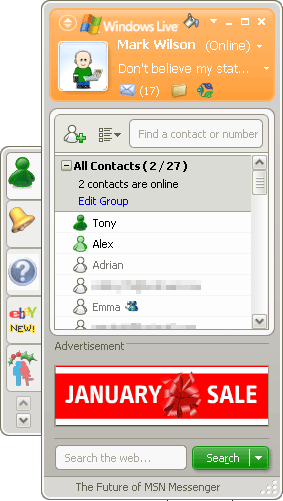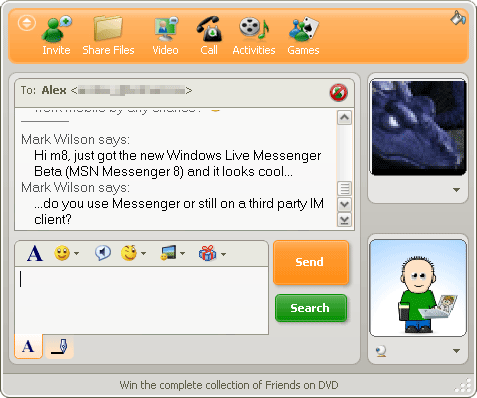Since last week, I’ve been using the new Windows Live Messenger Beta (formerly MSN Messenger 8) and I’m really impressed.
The main new feature is the integration of Windows Live Call VOIP technology, courtesy of Microsoft’s link up with MCI, combined with increased customisation and improved document sharing capabilities.
I particularly like the new interface (shown below); however the main improvement for me (after just a few days) is the ability to send messages to my contacts when they are offline (although one of my colleagues did wryly comment that’s what e-mail is for).


Meanwhile, I’ve also heard reports of an MSN Messenger 8 virus (Virkel-F). Along with various news sources (although I can’t find anything on the Symantec or Sophos sites) F-Secure is reporting that there is a new virus posing as an invitation to join the MSN Messenger 8 Working Beta.
The problem compounded by the fact that, as the screenshot below shows, the Windows Live Messenger Beta does include references to itself as Messenger 8.0 BETA. Furthermore, I was given the opportunity (through a link within the product) to invite five friends to join the beta and even though the e-mail invitation links to a Microsoft site to download the product, it’s still confusing to end users.

One thing’s for sure. Microsoft’s Windows Live products need to be good. Google is launching new products almost by the day and as I’m writing this, Google’s plans for online dominance are even featuring on the BBC’s 10 O’Clock News, as the broadcaster refers to Google as “innovative and extremely focused” and commenting that “Google is challenging [Microsoft’s] dominance, and it shows”. Meanwhile, today’s Windows IT Pro magazine network WinInfo Daily Update quotes Bill Gates as seeing IBM as Microsoft’s most significant threat, stating that “IBM has always been our biggest competitor. The press just doesn’t like to write about IBM”. It’s true, Apple and Google are the media darlings of the moment, although as Google’s dominance continues to grow, one has to wonder if they too will fall foul of industry regulators as someone complains about their software bundling.
